The weight of a Mustang GT varies by model, options, and year. Since managing weight is so important, here is a master list of all the Mustang model years and their gross weight.
In an effort to measure similar models, only the estimated equivalent of the Mustang GT, the true everyman’s sports car, is factored into this table. Halo versions, supercharged, or limited editions such as the SN Cobra, Cobra Jet or Shelby/SVT models are not included.
Year |
Curb Weight |
Horsepower |
lbs/hp Ratio |
Model Name |
| 2020 (est) | 3,750 | 470 | 7.98 | Mustang Fastback GT (Est.) |
| 2019 | 3,706 | 460 | 8.06 | Mustang Fastback GT |
| 2018 | 3,706 | 460 | 8.06 | Mustang Fastback GT |
| 2017 | 3,706 | 435 | 8.52 | Mustang Fastback GT |
| 2016 | 3,706 | 435 | 8.52 | Mustang Fastback GT |
| 2015 | 3,706 | 435 | 8.52 | Mustang Fastback GT (6th gen) |
| 2014 | 3,618 | 420 | 8.61 | Mustang GT |
| 2013 | 3,618 | 420 | 8.61 | Mustang GT |
| 2012 | 3,602 | 412 | 8.74 | Mustang GT |
| 2011 | 3,604 | 412 | 8.75 | Mustang GT |
| 2010 | 3,530 | 300 | 11.77 | Mustang GT |
| 2009 | 3,483 | 300 | 11.61 | Mustang GT |
| 2008 | 3,483 | 300 | 11.61 | Mustang GT |
| 2007 | 3,483 | 300 | 11.61 | Mustang GT |
| 2006 | 3,483 | 300 | 11.61 | Mustang GT |
| 2005 | 3,483 | 300 | 11.61 | Mustang GT (5th gen) |
| 2004 | 3,274 | 260 | 12.59 | Mustang GT Coupe |
| 2003 | 3,274 | 260 | 12.59 | Mustang GT Coupe |
| 2002 | 3,285 | 260 | 12.63 | Mustang GT Coupe |
| 2001 | 3,285 | 260 | 12.63 | Mustang GT Coupe |
| 2000 | 3,243 | 260 | 12.47 | Mustang GT Coupe |
| 1999 | 3,243 | 260 | 12.47 | Mustang GT Coupe |
| 1998 | 3,227 | 225 | 14.34 | Mustang GT Coupe |
| 1997 | 3,287 | 215 | 15.29 | Mustang GT Coupe |
| 1996 | 3,278 | 215 | 15.25 | Mustang GT Coupe |
| 1995 | 3,335 | 215 | 15.51 | Mustang GT Coupe |
| 1994 | 3,313 | 215 | 15.41 | Mustang GT Coupe (4th Gen) |
| 1993 | 3,144 | 205 | 15.34 | Mustang GT |
| 1992 | 3,144 | 225 | 13.97 | Mustang GT |
| 1991 | 3,190 | 225 | 14.18 | Mustang GT |
| 1990 | 3,159 | 225 | 14.04 | Mustang GT |
| 1989 | 3,194 | 225 | 14.20 | Mustang GT |
| 1988 | 3,192 | 225 | 14.19 | Mustang GT 5.0L |
| 1987 | 3,080 | 225 | 13.69 | Mustang GT 5.0L |
| 1986 | 3,108 | 200 | 15.54 | Mustang GT 5.0L |
| 1985 | 3,128 | 210 | 14.90 | Mustang GT 5.0L |
| 1984 | 3,031 | 175 | 17.32 | Mustang GT 5.0L |
| 1983 | 3,053 | 175 | 17.45 | Mustang GT 5.0L |
| 1982 | 2,751 | 157 | 17.52 | Mustang GT 5.0L |
| 1981 | 2,853 | 120 | 23.78 | Mustang Cobra 4.2L |
| 1980 | 2,811 | 120 | 23.43 | Mustang 2-door 4.2L |
| 1979 | 2,855 | 143 | 19.97 | Mustang Cobra 5.0L (3rd Gen) |
| 1978 | 3,009 | 139 | 21.65 | Mustang II Cobra II 5.0L |
| 1977 | 3,075 | 139 | 22.12 | Mustang II Cobra II 302 |
| 1976 | 3,111 | 134 | 23.22 | Mustang II Cobra II 302 |
| 1975 | 3,223 | 133 | 24.23 | Mustang II Ghia 302 |
| 1974 | 2,923 | 105 | 27.84 | Mustang II Mach I 2.8L V-6 (2nd Gen) |
| 1973 | 3,529 | 243 | 14.52 | Mustang Mach I 351 |
| 1972 | 3,492 | 275 | 12.70 | Mustang Grande 351 H.O |
| 1971 | 3,448 | 285 | 12.10 | Mustang Mach I 351 4V |
| 1970 | 3,307 | 300 | 11.02 | Mustang Hardtop 351 4V V-8 |
| 1969 | 3,441 | 335 | 10.27 | Mustang GT Hardtop 428 |
| 1968 | 3,313 | 325 | 10.19 | Mustang GT Hardtop 390 Thunderbird Special |
| 1967 | 3,152 | 320 | 9.85 | Mustang GT Hardtop 390 |
| 1966 | 2,939 | 271 | 10.85 | Mustang GT Hardtop Challenger |
| 1965 | 2,914 | 225 | 12.95 | Mustang Hardtop Challenger |
| 1964 | 3,014 | 271 | 11.12 | Mustang Hardtop 4V/289 |
Mustang GT Weight Summary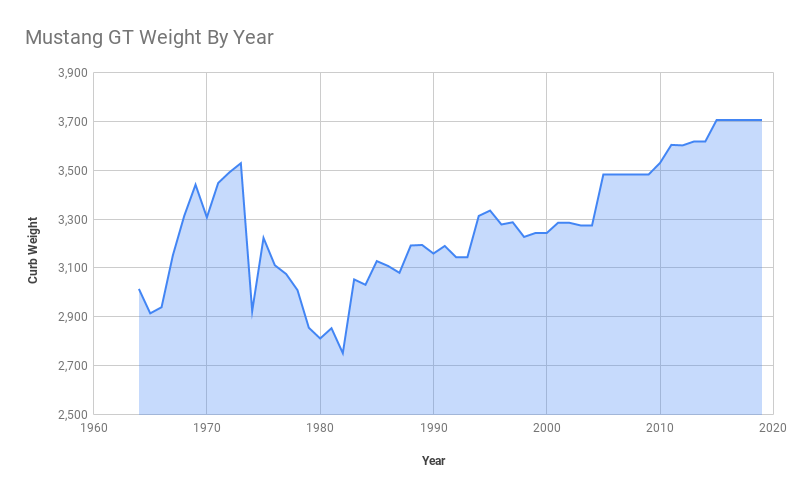
The weight of the Mustang has varied over the years to meet the changing demands of the time.
The first few model years launched a car with a relatively small weight, especially when it comes to modern cars. The engine itself was also relatively small compared to later models. I believe that this adds to the everlasting appeal of 1964 and 1965 Mustangs. They are handsome and simple. It was designed as an everyman’s car and to be as approachable as possible.
Towards the end of the
The early
The V8 didn’t return until the Mustang Ghia in 1975, though since it only made 133 horsepower, this is considered the Dark Ages of the Mustang. The V8 added another 300 lbs to the body of the car compared to the V6 the year before.
After bottoming out in 1982 at 2,751 lbs, the Mustang’s weight has slowly increased due to safety regulations and design changes.
Weight was holding strong at around 3,250 lbs with the SN bodies until 2005 when the 5th gen arrived. Luckily, it also brought the 4.6L V8 with it, making 300hp. This helped it lower it’s weight to horsepower ratio below 12 for the first time since 1972.
The last big jump in weight we see is in 2011 with the introduction of the Coyote engine. Even though the chassis was roughly the same from 2010 to 2011, the car gained another 130 lbs. Of course, I doubt any 3V owner would complain about the extra weight if they could get a coyote of their own!
Mustang Weight Reduction Options
The key to making your Mustang faster is going to be weight reduction (or forced induction).
As a rule, you always want to try to remove weight from the front of the car first, especially in straight-line racing. This will allow the front end of the car to come up when launching and move the center of gravity onto the rear tires. Any extra weight on the rear of the car will certainly help traction.
Some common steps that you can take to reduce the weight of your Mustang include removing any
Next, it’s best to look at removing unsprung weight from the car, especially if it is part of the drivetrain. Ancient Mustangs have a lot of extra weight because manufacturing was not as advanced as it is today. There was no laser measurement or robots to carefully cut components.
Although replacing components is always preferred, “Speed Holes” were not uncommon back in the day.
In short, if you want to go faster, toss out any parts of the car that you don’t need and replace existing parts with modern light-weight materials such as
Here’s a short list:
- Empty the trunk of
equiptment such as the spare and jack. - Remove anything from the cabin that is not required such as floor mats, glove box, and anything in your center console.
- Ditch the back seat (if you have one) and the rear deck cover.
- Change the battery to a lighter version
- Go for lighter wheels
- Lighter lower control arms
- Aftermarket exhaust systems save quite a bit of weight.
- Aftermarket driveshaft replacement
- Ditch your front sway bar
- Lighter flywheel and pressure plate
- Smaller front control arms and suspension
- Replace the heavy K member with a much lighter version. (We always recommend BMR)
- Change the seats or remove
passenger seat, if possible. 2014 Mustang GT Premium seats weigh almost 90 lbs! - Change the brake disks and calipers to smaller and lighter versions made for drag racing.
- Lightweight bumpers are available for most models.
- Remove stereo
equiptment - Replace the hood and trunk with lighter parts such as Carbon Fiber.
Mustang GT Power to Weight Ratio Over Time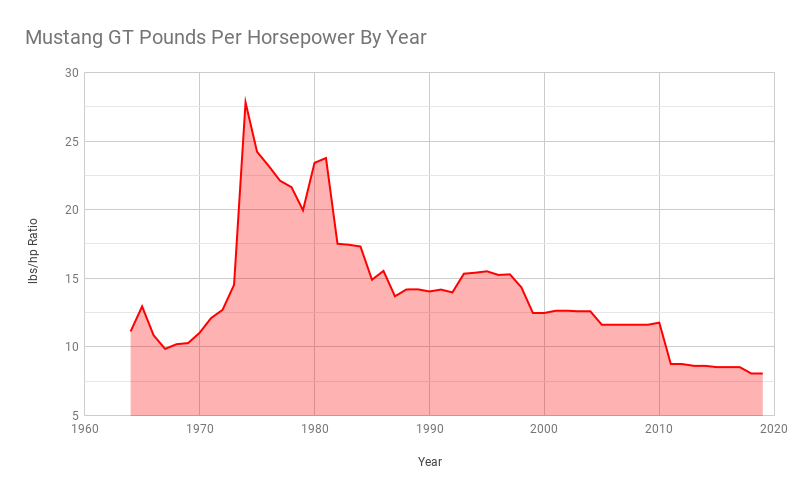
An interesting thing to consider when looking at the weight of the different models is the power to weight ratio. After all, if a car has enough power to accelerate quickly, it doesn’t matter quite as much if it’s heavy.
This is why the Hellcat models get so much attention and can provide impressive performance. Even though they’re as big as boats, with enough power, even they can run 9s!
As you can see from the chart to the right, something interesting happened with the introduction of the coyote engine in 2011. The number of pounds moved by the engine of the Mustang GT in 2011 dipped below the ratio of the 1967 Mustang GT 390. All thing equal, this means that commonly produced Mustangs didn’t provide the same level of power that Mustangs built 40 years earlier could provide!
It makes sense why the aftermarket parts manufacturers are so successful. Ford released the Mustang GT with great results, but then the oil embargo completely ruined the market for powerful cars. Aftermarket parts stepped in to help newer cars recapture the performance that made these cars great from the start.
Mustang GT 0-60 ET and 1/4 Mile Time By Year
Model |
0-60 |
1/4 |
|
2015 Ford Mustang GT (Manual)
|
4.3 | 12.8 |
|
2014 Ford Mustang Roush Stage 3
|
4.4 | |
|
2013 Ford Mustang GT 5.0 Convertible
|
4.5 | 12.9 |
|
2012 Ford Mustang Boss 302
|
4 | 12.1 |
|
2011 Ford Mustang GT 5.0
|
4.3 | 12.8 |
|
2010 Ford Mustang GT
|
4.9 | 13.5 |
|
2009 Ford Mustang GT
|
5.2 | 13.6 |
|
2008 Ford Mustang Bullitt
|
4.9 | 13.4 |
|
2007 Ford Mustang Shelby GT
|
4.9 | 13.4 |
|
2005 Ford Mustang GT
|
5 | 13.3 |
|
2003 Ford Mustang Mach 1
|
4.6 | 13 |
|
2001 Ford Mustang Bullitt GT
|
5.5 | 13.9 |
|
2000 Ford Mustang Roush Stage 3
|
5 | 13.3 |
|
1999 Ford Mustang GT
|
5.4 | 13.9 |
|
1998 Ford Mustang Cobra SVT
|
5.3 | 13.9 |
|
1996 Ford Mustang GT
|
6.7 | 15.1 |
|
1995 Ford Mustang
|
9.8 | 17.1 |
|
1994 Ford Mustang GT
|
6.6 | 14.9 |
|
1993 Ford Mustang GT
|
7.9 | 15.9 |
|
1992 Ford Mustang LX
|
6.1 | 14.6 |
|
1991 Ford Mustang GT
|
7.2 | 15.6 |
|
1990 Ford Mustang LX
|
6.3 | 14.7 |
|
1989 Ford Mustang GT
|
6.1 | 14.6 |
|
1988 Ford Mustang GT
|
6.3 | 15 |
|
1987 Ford Mustang GT
|
6.3 | 15 |
|
1985 Ford Mustang GT
|
6.3 | 14.7 |
|
1984 Ford Mustang SVO
|
7.8 | 15.6 |
|
1983 Ford Mustang GT
|
7.4 | 15.9 |
|
1982 Ford Mustang GT 302
|
6.8 | |
|
1980 Ford Mustang
|
11.7 | 18.3 |
|
1980 Ford Mustang Cobra
|
10.8 | 17.9 |
|
1977 Ford Mustang II
|
11.2 | 17.5 |
|
1974 Ford Mustang II
|
14.1 | 18.6 |
|
1973 Ford Mustang
|
8.8 | 16.1 |
|
1971 Ford Mustang
|
5.7 | 13.8 |
|
1971 Ford Mustang Boss 351
|
5.7 | 13.6 |
|
1970 Ford Mustang Boss 302
|
6.4 | 14.7 |
|
1969 Ford Mustang Mach 1
|
5.6 | 14.1 |
|
1967 Ford Mustang
|
7.3 | 15.4 |
|
1966 Ford Mustang
|
10.8 | 17.7 |
|
1964 Ford Mustang
|
7.3 | 15.5 |
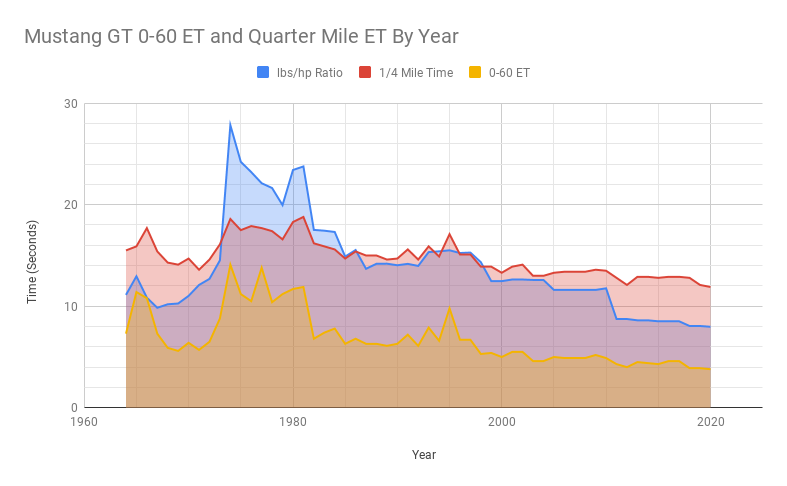
The 1960s were awesome for cars. That’s what this chart tells me. But the party was over by 1972.
I got this data from a variety of unreliable sources, so take it with a grain of salt. Not only are test track numbers from Manufacturers legendarily sketchy, but they’re from at least one source removed.
However, this is interesting. The early 70s Mustang GT put down such amazing acceleration numbers that they wouldn’t be logged again until 1998!
Of course, a 13-second quarter mile doesn’t even require a helmet at my track, so I might be getting a little too excited, but it just goes to show how miserable 1973 through 1997 were for Mustangs.
To give you some perspective, Motortrend got their test 2018 EcoBoost Mustang up to 5.3 seconds to 60 mph and 13.9 seconds. That’s better than every Mustang GT up to 2002. The cars that I would drool over as a kid aren’t any faster than the Secretary’s Car.
Were the Mid-1970s Mustangs Even Mustangs?
Looking over the data, there’s a hard argument to make about the cars that carried the Mustang name in the 70s.
But why did this happen? According to this chart, gas prices increased quite a bit from $1.62 to $2.03 (In today’s dollar). $2.03? That’s slightly less than what we pay here in Chicago.
Not until 1980 during the second oil crisis did things get really crazy at nearly $3 per gallon. Just looking at gas prices alone makes you wonder.
Was a $0.50 increase in a gallon of gas worth it to kill the horsepower wars of the 1970s?
Instead, Ford thought to use the Mustang brand to push another kind of car, the Mustang II with a tiny engine.
Essentially, it was a compact car.
Why, Ford, why?
Image Source: Titlemax.com
Sources of Mustang Information
Since I don’t have 50 years of cars on hand to test myself, this information was taken from various sources.
I’d like to thank the following sites for their data.
How to Make Your Mustang GT Exhaust Crackle and Pop
An exhaust that crackles and pops is one of the best parts about driving a Mustang. Having an exhaust that leaves a thick, throaty burble in its wake is a touchstone of American muscle cars and hot rods making big power. What’s the easiest way to get your exhaust to...
read moreWhat Does an Anti-Roll Bar Do for an S197 Mustang?
Anti-roll bars are a common upgrade for S197s to improve affect handling. I did some research to figure out the difference between the models out there. What does an anti-roll bar do for an S197 Mustang? Anti-roll bars, or sway bars, prevent the body of the car from...
read moreHow to Run a Mustang Supercharger in Cold Weather
How can you protect your supercharged, 600+hp mustang in the winter? I did some research on what the warning in the manual for 25F actually means! Daily driving a Coyote Mustang has been one of the best experiences, especially after I lucked into a used Paxton...
read more
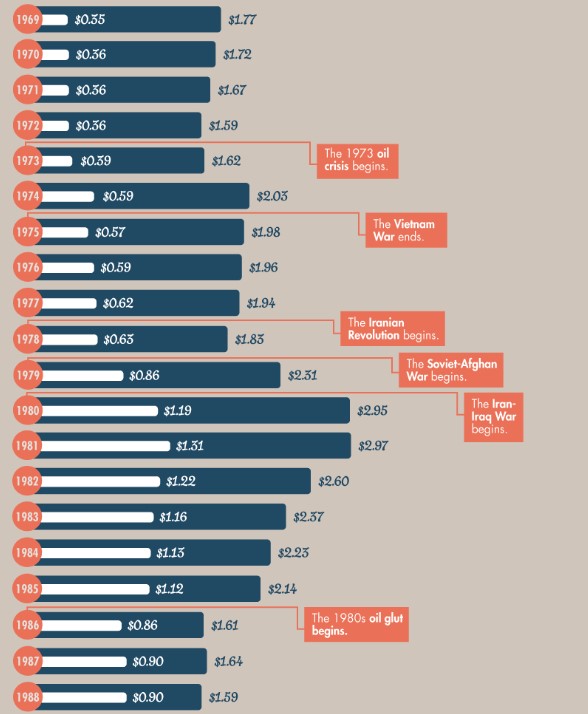

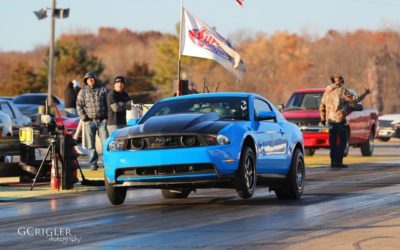

Recent Comments